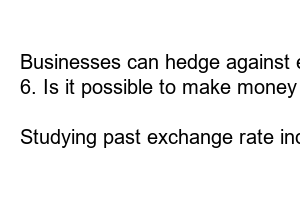과거 환율조회
Title: Unveiling the Secrets Behind Past Exchange Rate Inquiry
Introduction:
In today’s increasingly globalized world, understanding exchange rates is crucial for making informed decisions about international trade, travel, and investment. However, have you ever wondered about the historical context and factors that influence exchange rates? This blog post aims to shed light on past exchange rate inquiries, offering actionable insights for anyone seeking a deeper understanding of this complex subject.
1. The Significance of Exchange Rates:
Exchange rates play a pivotal role in determining the value of one currency relative to another. They directly impact exports, imports, inflation, and even interest rates. By delving into past exchange rate inquiries, we can uncover patterns and learn from historical trends to navigate today’s dynamic global economy effectively.
2. Historical Exchange Rate Movements:
By analyzing past exchange rate data, we can identify various historical events that caused significant fluctuations. For instance, the oil price shock of the 1970s had a profound impact on global currencies, while the collapse of the Bretton Woods system in the early 1970s led to a floating exchange rate regime. Understanding these movements can help individuals and businesses anticipate and adapt to future changes.
3. Factors Influencing Exchange Rates:
Exchange rates are influenced by numerous factors, including economic indicators, political stability, central bank policies, and market sentiment. Investigating past inquiries allows us to identify how these factors have influenced exchange rates in the past and how they might continue to do so in the future. Staying informed about these factors empowers individuals to make well-informed decisions in international transactions.
4. How to Look Back and Analyze Exchange Rates:
To gain insights from historical exchange rates, financial analysts and economists rely on various analytical tools and techniques. Some common approaches include technical analysis, fundamental analysis, and studying historical patterns and correlations. By delving into these methods, one can uncover invaluable information about past rates and their implications.
5. Learning from the Past for Smarter Actions:
Above all, studying past exchange rate inquiries offers a unique opportunity to learn from mistakes and successes to make smarter decisions in the present. By analyzing the consequences of previous actions, individuals can adjust their strategies and approaches, minimizing potential risks and maximizing potential gains in an uncertain global market.
6. Exchange Rate Forecasts:
While the past may not predict the future with certainty, studying historical exchange rate inquiries can help generate informed forecasts. Experts leverage their knowledge of past trends, current events, and economic indicators to predict potential future exchange rate movements. Though not infallible, these forecasts can inform individuals’ decisions and assist them in developing effective risk management strategies.
FAQs:
1. How often do exchange rates change?
Exchange rates fluctuate constantly, reflecting ongoing changes in the global market. Factors such as economic news, geopolitical events, and central bank actions can trigger rapid shifts.
2. Can I predict future exchange rate movements based on the past?
While historical data provides insights, exchange rates are influenced by numerous dynamic factors. Therefore, predictions should be made cautiously, taking into account both historical patterns and current market conditions.
3. Which economic indicators affect exchange rates the most?
Key economic indicators, such as inflation, interest rates, GDP growth, and employment figures, all have significant impacts on exchange rates. Monitoring these indicators is crucial for understanding potential currency movements.
4. Can currency exchange rates impact international tourism?
Yes, currency exchange rates directly impact international tourism. A stronger domestic currency often makes traveling abroad more expensive for residents, while a weaker currency attracts more tourists due to lower costs.
5. How can businesses protect themselves from exchange rate fluctuations?
Businesses can hedge against exchange rate fluctuations by implementing risk management strategies such as forward contracts, options, or netting. These methods help protect against potential losses in foreign currency transactions.
6. Is it possible to make money by trading currencies based on past trends?
Currency trading involves risks, and past trends are not foolproof indicators of future performance. Individuals interested in trading currencies should consult with professionals and continuously stay updated on market dynamics.
Summary:
Studying past exchange rate inquiries provides valuable insights into historical currency movements, their driving forces, and their implications. By understanding the significance of exchange rates and the factors influencing them, individuals and businesses can make more informed decisions, anticipate potential risks, and capitalize on opportunities. While past trends cannot predict future movements with certainty, they offer guidance for creating effective strategies and managing risks in an ever-evolving global market.

